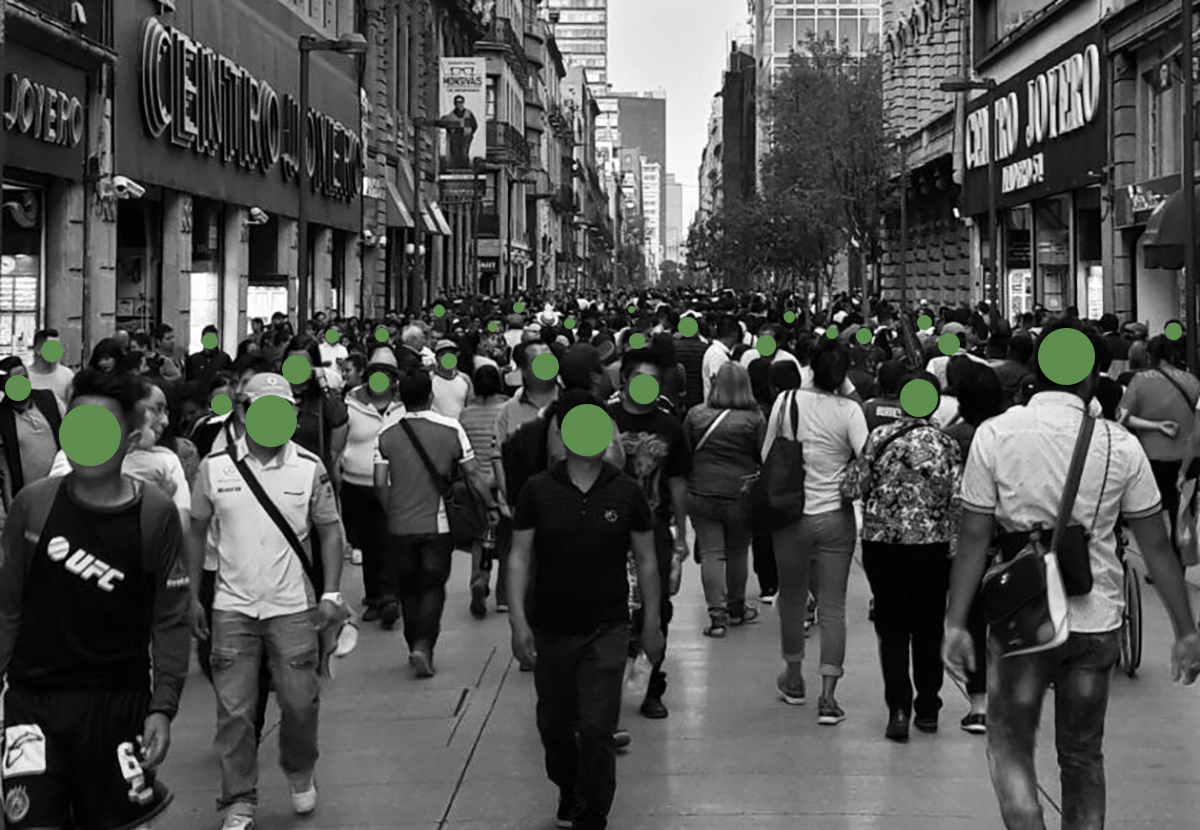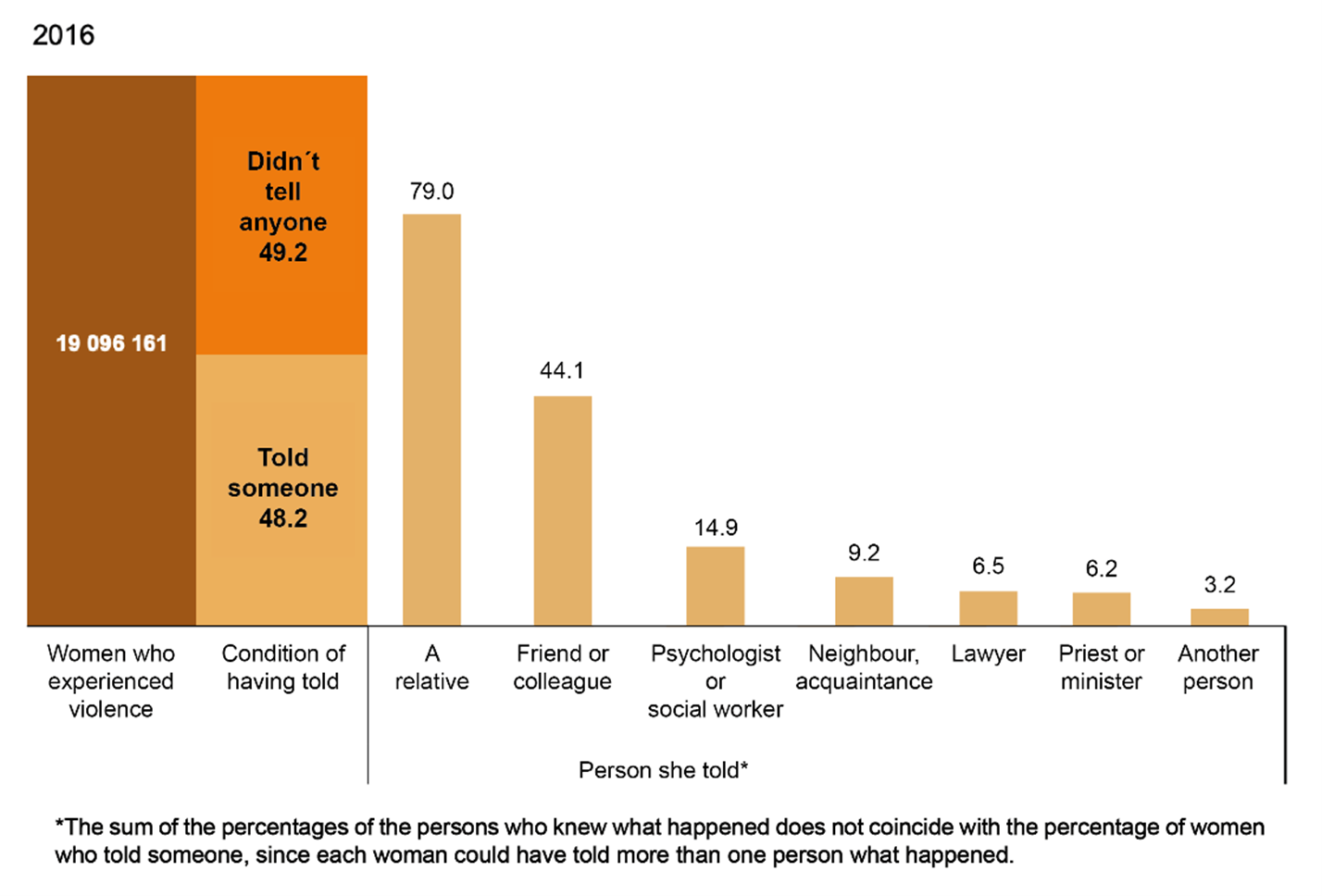A new UNDP learning cycle, carried out with the Ministry of Women of Mexico City and UN Women, encourages people close to victims of gender-based violence to be agents of change
Gender-based violence is a collective challenge: What role can we all play?
11 de Julio de 2022

How many people witness gender-based violence?
Authors: Gabriela Ríos Landa, Head of Exploration at the Accelerator Lab; Adriana Alvarado, Intern at the Accelerator Lab; and Jorge Munguía, Head of Solution Mapping at the Accelerator Lab.
In Mexico, 66 out of every 100 women aged 15 and over have suffered at least one incident of emotional, economic, physical, sexual violence, or discrimination in at least one area of their lives, according to the results of the National Survey on the Dynamics of Relationships in Households (ENDIREH) of 2016. More recently, we found that, following the isolation measures implemented in response to the COVID-19 pandemic in early 2020, violence against women and girls within the family context increased considerably compared to previous years. According to the study "The two pandemics: Violence against women in Mexico in the context of COVID-19" the number of calls to the Mexico City Women's Line related to family violence during April and May 2020 increased by 97% compared to those registered in the same months in previous years. Likewise, in March 2020, 20,232 investigation folders were created for the crime of family violence in the country's state prosecutor's offices, thus being the most significant number since the nationwide registration of this crime began in 2015.
To address this problem, civil society organizations and governments have created different strategies to prevent, manage and eradicate violence against women, which have focused on awareness-raising activities for various populations such as teenage boys and girls and adult men. These strategies have also consisted of prevention interventions in public spaces, including public transport and pedestrian crossings, and legal and psychological advice for women victims of violence and their children, as is the case of "Centros Lunas.”
People around women who experience gender-based violence
The results of the ENDIREH 2016 indicate that victims tend to share their situation with people close to them. For example, of the approximately 19.1 million women who reported at least one act of violence by their current or last partner, over 9 million women (48.2%) shared it with one or more people. Of these women, around 7 million (79.0%) shared their experience with a family member, 4 million (44.1%) with friends or colleagues, and approximately 828,558 women (9.2%) with neighbors or acquaintances[ii]. Considering these data, we could assume that at some point, at least 9 million potential witnesses knew of an act of violence directly from the victim and could have assisted or provided help.

Distribution of women aged 15 and over who experienced violence by their current or last partner throughout the relationship, by condition, and by the person to whom they told what happened
This is exclusively in the case of intimate partner violence; however, there are multiple types of violence that women and girls suffer in different contexts of daily life, such as family, school, work, public spaces, and digital media. And in each of these contexts, women are surrounded by relatives, friends, neighbors, colleagues, teachers, peers, etc., who possibly hear, witness, or sense a case of violence.
Given that most of the existing strategies and interventions, such as those mentioned at the beginning of this blog, focus on victims as primary users, and considering the ENDIREH data, we believe there is an opportunity to design solutions focused on people who witness cases of violence.
That is why, in the Accelerator Lab and the Gender Unit of the United Nations Development Programme (UNDP), in collaboration with UN Women in Mexico, we began a learning cycle to involve people close to the phenomenon of gender-based violence (e.g., neighbors, relatives, friends) in the eradication of this problem.
Specifically, we seek to bring information and advise people close to victims of gender-based violence to leverage their potential proximity to the phenomenon and turn them into agents of change.
In this cycle, we are collaborating with the Ministry of Women of Mexico City to improve and add to the existing solutions of the local government and incorporate tools that allow addressing gender-based violence from the dimension of the people in the proximity circle of the victims.
Sensemaking: the beginning of our learning cycle
The challenge we have set ourselves for this new learning cycle is: Reduce the risk of violence women suffer in Mexico City by incorporating technological tools that bring relevant information and practical tools to people close to the phenomenon of violence to turn them into agents of change.
To do so, we began with a sensemaking process, which consists of constructing meaning to understand and integrate connections between people, places, and events that occur or have occurred to anticipate future paths and react accordingly[iii]. To guide our process, we defined a series of learning questions:
- What roles can third parties play in the phenomenon of violence against women, girls, and teenagers?
- What beliefs or models motivate or prevent people who witness gender-based violence from getting involved in one way or another?
- What kind of information or indicative signs of gender-based violence are present in society?
- What actors work so that witnesses can be agents of change in the fight against gender-based violence?
- What solutions exist so that people who witness an act of violence can be agents of change in the fight against gender-based violence?
- What characteristics have technological solutions had or currently have to encourage people to become an agent of positive change in the phenomenon of gender-based violence?
To begin our sensemaking process, we reviewed existing studies and solutions to create a map of the experiences that people close to a victim of gender-based violence might go through.
Where is our learning cycle headed?
We will approach this problem through the design and prototyping of a technological tool, as we believe that this will allow us to bring relevant information to people so that they know how they could act in case they know of a case of gender-based violence.
The sensemaking process will allow us to identify the limits of the possible technological solution since we know that not everything can be addressed through technology. However, we want to find those entry points where technology can add value so that we collectively face gender-based violence.
Soon, we will share our progress in this space.
Do you work on any initiative to help people who witness acts of gender-based violence to become agents of change? Contact us at acclabmx@undp.org!
References:
[i]Intersects, EQUIS Justice for Women, and the National Shelter Network, AC. (2020). The two pandemics: Violence against women in Mexico in the context of COVID-19. EQUIS Justice for Women.https://equis.org.mx/wp-content/uploads/2020/08/informe-dospandemiasmexico.pdf
[ii]INEGI. (2020, November 23). Statistics on the international day for the elimination of violence against women. Source: https://www.inegi.org.mx/contenidos/saladeprensa/aproposito/2020/Violencia2020_Nal.pdf
[iii]Kolko, J. (2011). Thoughts on interaction design: A collection of essays. Morgan Kaufmann Elsevier Publications.

 Locations
Locations
